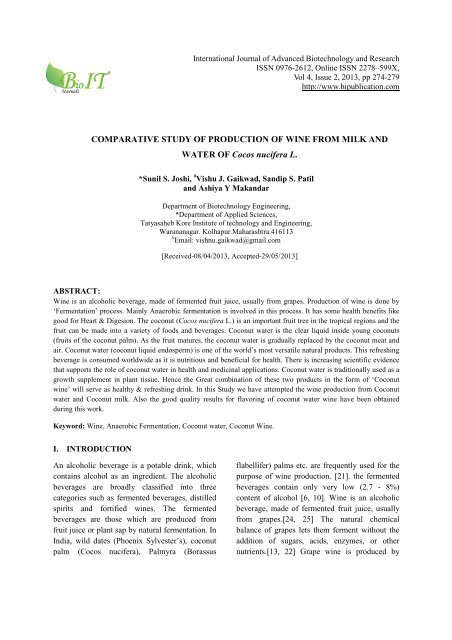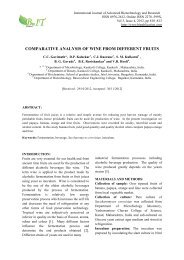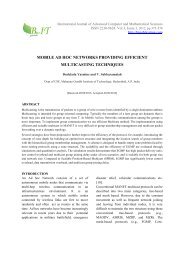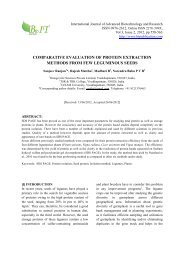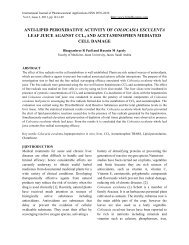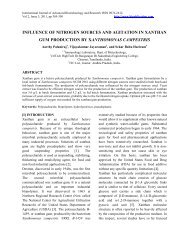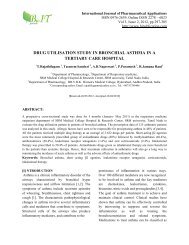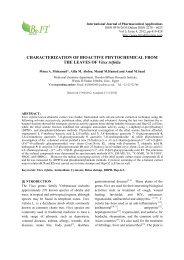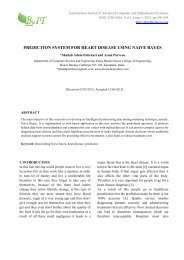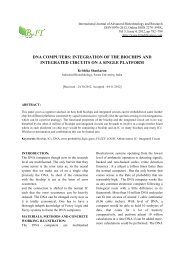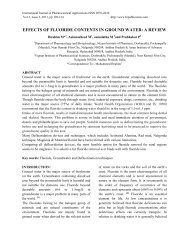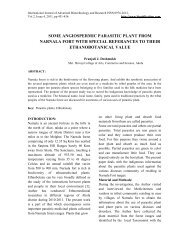COMPARATIVE STUDY OF PRODUCTION OF WINE FROM MILK ...
COMPARATIVE STUDY OF PRODUCTION OF WINE FROM MILK ...
COMPARATIVE STUDY OF PRODUCTION OF WINE FROM MILK ...
Create successful ePaper yourself
Turn your PDF publications into a flip-book with our unique Google optimized e-Paper software.
International Journal of Advanced Biotechnology and ResearchISSN 0976-2612, Online ISSN 2278–599X,Vol 4, Issue 2, 2013, pp 274-279http://www.bipublication.com<strong>COMPARATIVE</strong> <strong>STUDY</strong> <strong>OF</strong> <strong>PRODUCTION</strong> <strong>OF</strong> <strong>WINE</strong> <strong>FROM</strong> <strong>MILK</strong> ANDWATER <strong>OF</strong> Cocos nucifera L.*Sunil S. Joshi, # Vishu J. Gaikwad, Sandip S. Patiland Ashiya Y MakandarDepartment of Biotechnology Engineering,*Department of Applied Sciences,Tatyasaheb Kore Institute of technology and Engineering,Warananagar. Kolhapur.Maharashtra.416113# Email: vishnu.gaikwad@gmail.com[Received-08/04/2013, Accepted-29/05/2013]ABSTRACT:Wine is an alcoholic beverage, made of fermented fruit juice, usually from grapes. Production of wine is done by‘Fermentation’ process. Mainly Anaerobic fermentation is involved in this process. It has some health benefits likegood for Heart & Digesion. The coconut (Cocos nucifera L.) is an important fruit tree in the tropical regions and thefruit can be made into a variety of foods and beverages. Coconut water is the clear liquid inside young coconuts(fruits of the coconut palm). As the fruit matures, the coconut water is gradually replaced by the coconut meat andair. Coconut water (coconut liquid endosperm) is one of the world’s most versatile natural products. This refreshingbeverage is consumed worldwide as it is nutritious and beneficial for health. There is increasing scientific evidencethat supports the role of coconut water in health and medicinal applications. Coconut water is traditionally used as agrowth supplement in plant tissue. Hence the Great combination of these two products in the form of ‘Coconutwine’ will serve as healthy & refreshing drink. In this Study we have attempted the wine production from Coconutwater and Coconut milk. Also the good quality results for flavoring of coconut water wine have been obtainedduring this work.Keyword: Wine, Anaerobic Fermentation, Coconut water, Coconut Wine.I. INTRODUCTIONAn alcoholic beverage is a potable drink, whichcontains alcohol as an ingredient. The alcoholicbeverages are broadly classified into threecategories such as fermented beverages, distilledspirits and fortified wines. The fermentedbeverages are those which are produced fromfruit juice or plant sap by natural fermentation. InIndia, wild dates (Phoenix Sylvester’s), coconutpalm (Cocos nucifera), Palmyra (Borassusflabellifer) palms etc. are frequently used for thepurpose of wine production. [21]. the fermentedbeverages contain only very low (2.7 - 8%)content of alcohol [6, 10]. Wine is an alcoholicbeverage, made of fermented fruit juice, usuallyfrom grapes.[24, 25] The natural chemicalbalance of grapes lets them ferment without theaddition of sugars, acids, enzymes, or othernutrients.[13, 22] Grape wine is produced by
<strong>COMPARATIVE</strong> <strong>STUDY</strong> <strong>OF</strong> <strong>PRODUCTION</strong> <strong>OF</strong> <strong>WINE</strong> <strong>FROM</strong> <strong>MILK</strong> AND WATER <strong>OF</strong> Cocos nucifera L.fermenting crushed grapes using various types ofyeast. Yeast consumes the sugars in the grapesand converts them into alcohol. Wine has a richhistory dating back thousands of years, with theearliest known production occurring around8,000 years ago on the territory of modern-dayGeorgia.[15, 24] Wine has also played animportant role in religion throughout history.The coconut (Cocos nucifera L.) is an importantfruit tree in the tropical regions and the fruit canbe made into a variety of foods and beverages.The edible part of the coconut fruit (coconut meatand coconut water) is the endosperm tissue.Endosperm tissues undergo one of three mainmodes of development, which are the nuclear,cellular and helobial modes [4, 14, 16] and thedevelopment of coconut endosperm belongs tothe nuclear mode. Initially, the endosperm is aliquid containing free nuclei generated by aprocess, in which the primary endosperm nucleusundergoes several cycles of division withoutcytokinesis. At first, the cellular endosperm istranslucent and jelly-like, but it later hardens atmaturity to become white flesh (coconut meat).Unlike the endosperms of other plants (e.g.,wheat and corn), the cellularization process in acoconut fruit does not fill up the entire embryosac cavity, but instead leaves the cavity solutionfilled.This solution is commonly known ascoconut water and it is of cytoplasm origin [6,10]. Nutrients from coconut water are obtainedfrom the seed apoplasm (surrounding cell wall)and are transported symplasmically throughplasmodemata, which is the connection betweencytoplasm of adjacent cells) into the endosperm[7]. Coconut water is the clear liquid insideyoung coconuts (fruits of the coconut palm). Asthe fruit matures, the coconut water is graduallyreplaced by the coconut meat and air. Coconutmilk is usually used as a food ingredient invarious traditional cooking recipes (The maincomponents of coconut milk are water, fat andprotein. whereas coconut water contains mainlywater. The aqueous part of the coconutendosperm is termed coconut water, whereascoconut milk refers to the liquid productsobtained by grating the solid endosperm, with orwithout addition of water. Also the Coconutwater has been known to have health benefitssuch as maintain the body at the propertemperature, carry nutrients and oxygen to cells,naturally replenish your body's fluids afterexercising, Promote weight loss, Boost yourimmune system, Cleanse your digestive tract,Treat kidney and urethral stones.[20] Wines madethrough single-yeast inoculation differ in sensoryproperties to those made by spontaneousfermentations, an observation reinforced bydifferences in chemical composition [21, 22, 25].This paper deals with the work of production ofCoconut Wine which is combination of these twoproducts. This paper mainly highlightsproduction of wine from coconut water &coconut milk which will be healthy andrefreshing drink.II. MATERIALS AND METHODS-2.1. For Coconut water wine2.1. 1.Collection of Coconut water- The firststep of this project was to collect raw materialwhich is coconut water from selected youngcoconuts. We have collected totally 5lit ofcoconut water from about 22 coconuts. Then itwas tested to determine BRIX i.e. sugarconcentration by using Refractometer. The initialBrix observed was 1%. The aim was to obtain thefinal Brix of solution up to 18%, so addition of850 grams of sugar. Again testing the solutionwith the help of Refractometer desired Brixpercent was confirmed. After the Brix adjustmentthe solution was kept for sterilization at 80 0 C for5 min in water bath. To complete the sterilizationit was then kept for cooling and 0.1g ofpotassium meta bisulphate was added.2.1.2. Inoculum preparation- Inoculumpreparation was done by activating Yeast in thehot water having temperature 40 0 c and somecoconut water was also added. Then 0.5 gm ofWine Yeast was added to above solution. MixtureVishu J. Gaikwad, et al. 275
<strong>COMPARATIVE</strong> <strong>STUDY</strong> <strong>OF</strong> <strong>PRODUCTION</strong> <strong>OF</strong> <strong>WINE</strong> <strong>FROM</strong> <strong>MILK</strong> AND WATER <strong>OF</strong> Cocos nucifera L.was allowed to react for 20 min. Then thismixture was used as inoculum. Now,fermentation media was inoculated with activatedyeast inoculum. Wine Yeast was taken fromKrishna Winery, Palus.2.1.3. Fermentation: To carry out our process ofwine production we had taken empty, roundmineral water container with air tight lid of 10Litre capacities.After addition of inoculum, thewhole solution was kept for fermentation infermentation vessel.Fermentation was done in two phases:Aerobic fermentation at first the media kept forprimary fermentation which is essential for initialgrowth of yeast cells. Total period required forprimary fermentation was of 5 days. Temperaturewas controlled at about 19 to 22 0 C.Fig: 2: -RackingFiltration-After completion of 3 racking, winewas filtered by using cheese cloth to get moreclear wine.2.2 For Coconut milk wine:2.2.1. Collection of Coconut milk:-At first fully mature Coconuts were collected.After this coconuts were broken to take outcoconut meet. This bulk of coconut meet wasthen washed with water. Then it was grinded withthe help of mixer with addition of water to obtainsomewhat thicker liquid known as ‘Coconutmilk’. This liquid was then filtered to removesolid waste from coconut milk. Then the milkwas stored in lid tight container & a pinch ofKMS was added to it to avoid contamination.Fig : 1: Aerobic fermentationAnaerobic fermentation-After completion ofaerobic fermentation, we have set fermentor foranaerobic fermentation by creating anaerobiccondition by fixing air tight lid to container. Herealso temperature was maintained at about 19-22 0 c. This process was carried out till the BRIXbecomes 0. Racking-When BRIX was reduced to0%, fermented media was kept for racking at 4-5 0 c for removal of dead yeast cells. For totalclarification 3 racking as 1 racking/ 15 days arerequired, hence total three racking were done.After racking a clear wine was obtained.Fig: 3:- Collected Coconut milkAfter collection of Coconut milk it was tested todetermine BRIX i.e. sugar concentration by usingRefractometer. We observed that the initial Brixwas 2%. Our aim was to obtain the final Brix ofsolution to 18%, so we added 800gms of sugari.e. sucrose to solution. Again testing the solutionVishu J. Gaikwad, et al. 276
<strong>COMPARATIVE</strong> <strong>STUDY</strong> <strong>OF</strong> <strong>PRODUCTION</strong> <strong>OF</strong> <strong>WINE</strong> <strong>FROM</strong> <strong>MILK</strong> AND WATER <strong>OF</strong> Cocos nucifera L.with the help of Refractometer desired Brixpercent was confirmed.2.2.2 Inoculum preparation-Inoculumpreparation was done by activating Yeast.The hot water having temperature 40 0 c was takenin conical flask. Approximately some coconutwater was added. Then 0.5gm of Wine Yeastwas added to above solution. Mixture wasallowed to react for 20 min. Then this mixturewas used as inoculum. Now, milk was inoculatedwith activated yeast inoculum.2.2.3. Fermentation- Fermentation was done intwo phases: a) Aerobic fermentation in which wehad first kept media for primary fermentationwhich is essential for initial growth of yeast cells.Total period required for primary fermentationwas of 5 days. Temperature was kept at about 19-22 0 c. b) Anaerobic fermentation in which we hadperformed anaerobic fermentation creatinganaerobic condition by fixing air tight lid tocontainer. Here also temperature was maintainedat about 19-22 0 c. This process was carried out tillthe BRIX becomes 0.2.3 Analytical testing:As the process of racking was completed, varioustesting were carried out to determine quality ofwine. Those tests are as following:1. Alcohol determination.2. Titrable Acidity (T.A)-The acids present in wine are tartaric acid, malic,succinic, acetic acid. So the titrable acidity wascalculated by using following formula-3. Volatile acidity:4. Sulphur Dioxide:a. free so 2 by idometry method done usingfollowing formula:Free SO 2 in ppm = ml of I 2 * normality of I 2 *32*1000/ wine sample.b. Total SO 2 by idometry method:Total SO 2 in ppm = ml of I 2 * normality of I 2 *32*1000/ wine sample.5. Stability tests like Heat Stability and Coldstability Test were analyzed.6. Methanol Presence Test-This test providesthe information about presence of methanol inwine. It is also helpful to know that methanol isin moderate or high quantity. These tests weredone using a. Litmus Paper Method. and b.Potassium-di-chromate Method.2.4. Flavoring: After completion of analyticaltesting we had decided to add flavors to the wine.The Flavoring agent’s like Lemon (To obtainlemon flavor), Vanilla (To obtain Vanilla flavor)and Lemon Grass were added.2.5 Aging- Along with addition of flavors, agingwas carried out by adding ‘Oak chips’ to eachcontainer of flavored wine. Aging was done forabout 1 month.III. Result and Discussion:a) For Coconut water wine:Observations and results for analyticaldetermination of Coconut wine as listed in table1.Also the physical tests and methanol tests wereperformed which were important regardingquality of wine. The results of these tests arelisted in table 2Vishu J. Gaikwad, et al. 277


